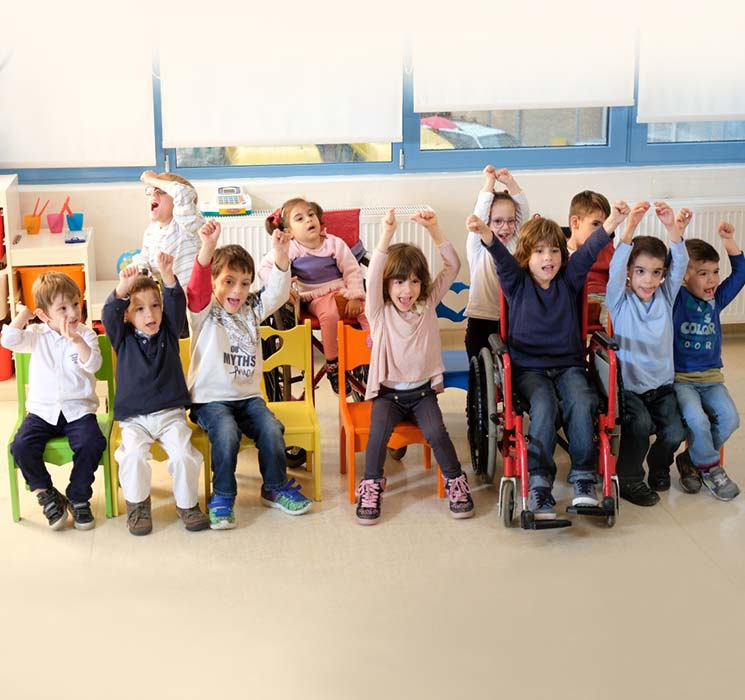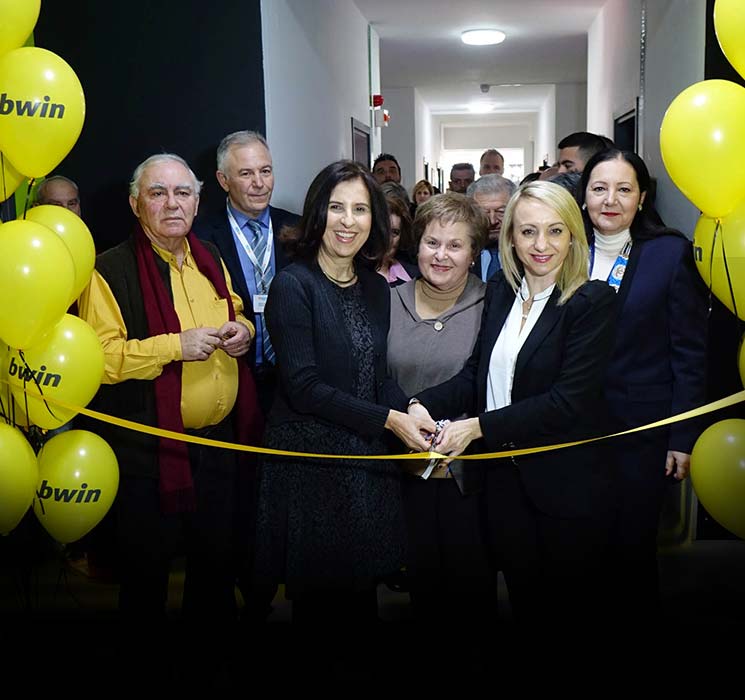Gait and Motion Analysis

Definition
Motion analysis is the systematic measurement, description and examination of the quantitative elements that characterize human movement. Until now, the treatment of gait or movement problems in people with neuromuscular diseases was based solely on physical examination, visual assessment of gait and selected radiological examination. This way is very subjective. The data are difficult to codify and it is not possible to objectively assess the results of the applied treatment (surgical - conservative).
In recent years, biomechanical science has developed a methodology for the objective evaluation of human movement, using the most modern technology. With the objective determination of the physiological parameters of gait, it became possible to identify the pathological f
Location - Staff
In 2001, ELEPAP Athens established the first Walking & Movement Analysis Center in Greece, which produces findings for the treatment of gait problems in children and adults according to international standards. The Walking & Motion Analysis Center of ELEPAP Athens is the best equipped center in Greece in the field of motion analysis. The specially trained staff of the center includes specialized orthopedists, biomechanics, specialized physiotherapists, as well as a physiatrist, members of the European Society of Motion Analysis in Adults and Children (ESMAC).

Gait Analysis
Children and adults from various specialties, medical and therapeutic, are referred to the Gait Analysis Center for the evaluation of gait disorders. Simple cases such as flat feet, leg cramps, clubfoot, etc., but mainly complex motor problems such as cerebral palsy, injuries, amputations, various syndromes, etc.
More specifically, the cases that the Gait Analysis helps are:
- Brain paralysis
- Acquired brain damage
- Syndromes with concomitant mobility problems
- Myelodysplasia - Myelomeningocele
- Traumatic brain injury
- Damages N.M. and peripheral nerves
- Myopathies
- Parkinson
- Imbalances for various reasons
- Rotational deformations of the lower extremities
- Evaluation of orthotics
- etc.
Purpose
The purpose of the application of Gait Analysis is to identify and document gait problems. The Gait Analysis exams are used: a) for the planning of surgeries and the monitoring of their results b) for the planning and monitoring of conservative treatment and c) for the planning and control of orthotics / prostheses.
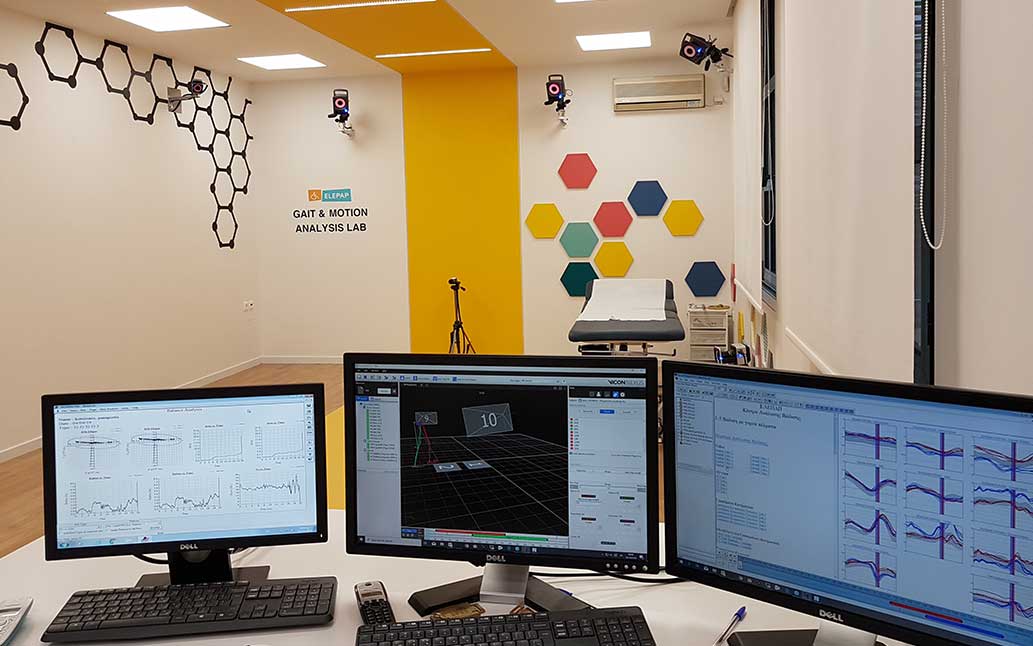
Extinction - Measurements
The gait and movement analysis laboratory of ELEPAP Athens has:
- 10 3D Cameras (3D Vicon Cameras)
- 2 2D digital cameras (Pentax & Panasonic digital Cameras)
- 2 power recording power floors (AMTI)
- 3 portable Electromyographs (Noraxon 8 channel)
- 1 pediatrician (Medicapture)
- 1 portable muscle strength meter (Hoogan)
- 1 adjustable clinical examination bed
- 5 computers
- 7 software for analysis of the above data.
The measurements that can be performed on a case-by-case basis are: 3D Kinematic Analysis, 3D Kinetic Analysis, Muscle Strength Analysis, Walking Electromyogram, Footprint (static / equilibrium and dynamic), Clinical Examination, Equilibrium Analysis, etc.
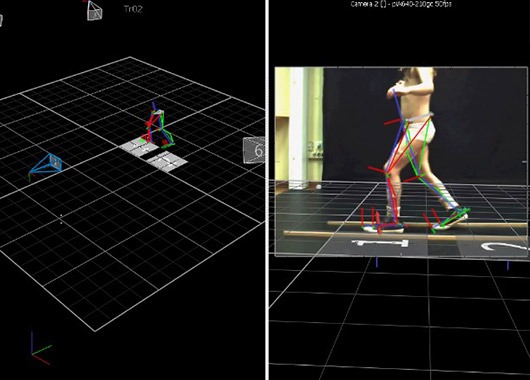
3D Kinematic Analysis
Kinematic analysis records the angular trajectory of the joints in motion at all three levels of the body. It also records the spatio-temporal elements of movement, such as speed, distance, pacing pace, periods of support and swing, etc. It has the ability to compare all joints, at each level for the right and left hemispheres and at the same time compare them with normal values.
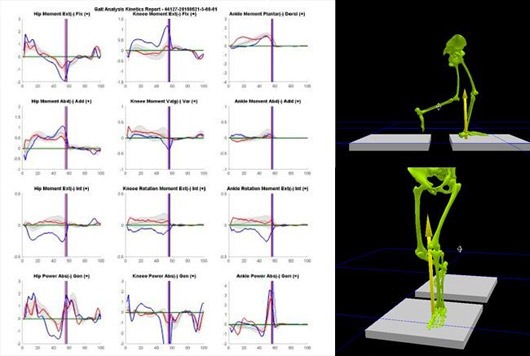
3D Kinetic Analysis
Kinetic analysis explains why the body moves in this way. Analyzes the reaction forces from the ground to each joint and at each level. In addition, it captures the torques applied to each joint, which result in the movement itself. Finally, it analyzes the power output for each joint.

Electromyographic Examination
The electromyogram measures the electrical activity of the muscles. It gives information about the activation of the muscles during the execution of complex movements and can compare the right with the left half, at the same time with the normal values.
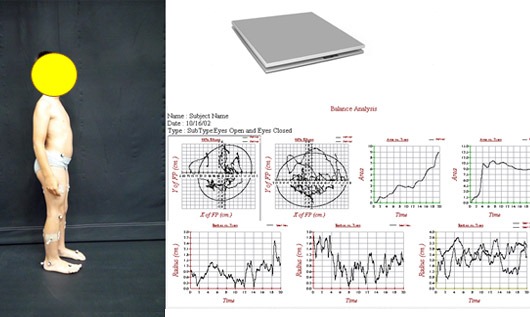
Equilibrium Analysis
In equilibrium analysis, the oscillation of the body above the support base is evaluated. The pressure point and how much it deviates from the normal data is measured. The most valid tests are to maintain balance with eyes open and closed. At the same time it can assess whether there is an asymmetric charge between the lower extremities.

Clinical Examination and Analysis of Muscle Strength Project
The clinical examination evaluates the trajectory of the joints, muscle strength, imbalance, skeletal deformities and deviations from normal, as well as skeletal rotations. Also, special neurological and musculoskeletal tests are applied.
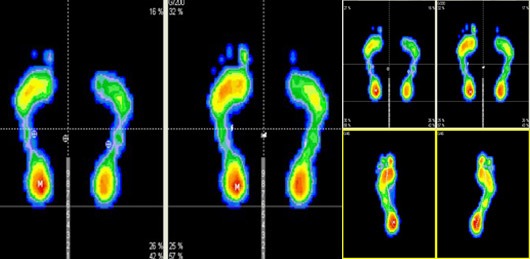
Footprint
The static and dynamic footprint helps to diagnose problems due to the anatomy of the foot (flatfoot, hamstring… etc.) as well as its function during walking. The problems that are identified are usually treated with orthotics. It concerns: flat feet, abdominoplasty, bladder feet, metatarsal heads fall, heel spurs, diabetic foot, rheumatoid arthritis, imbalances, axial deformities of the lower extremities, congenital clubfoot, etc. Referral conditions: a) good cooperation of a child and b) age over 3 years.

Finding
The above data (Kinematic Analysis – Kinetic Analysis), are combined with Clinical Examination, Somatometric Analysis, Static Equilibrium Analysis and Muscle Work-Strength Analysis. Thus, more than 200 parameters are gathered to compile the conclusion. The data are analyzed by a specialized scientific team consisting of Biomechanics, Physiotherapist and Orthopedic Surgeon. Finally, a report is created with observations from the comparison of the data of the examinee with the expected normal ones, in order to arrive at the final conclusion.

Conditions
Conditions for referral are: a) the examinee walks independently or with some help, b) his age is over 5 years and c) communication and cooperation with the referrer for his full information.
The ever-accumulating literature and know-how, as well as international practice, concludes that Gait and Motion Analysis is an invaluable tool in decision-making for dealing with complex mobility problems.

